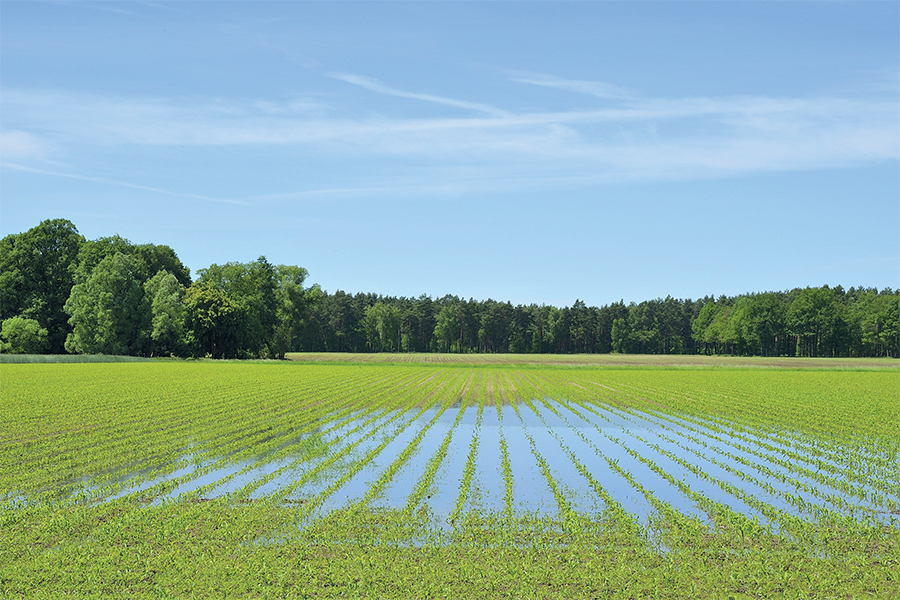Protect yield potential with well-drained land
7th September 2024
Drainage forms the building blocks of all land management. Here, the NAAC provides its best practice drainage advice.

This year in the UK saw crops devastated after months of heavy rain. Without good drainage, whether through good soil structure alone, or via a man-made drainage system, you can apply all the principles of sustainable, productive farming but the land won’t reach its optimal potential.
A wet patch (or patches) can destroy a field’s yield potential, whilst making it more difficult to travel on and more challenging to manage. In the past year we have seen fields standing fallow, saturated or flooded and unable to bear cropping. Whilst the weather is out of our control, we can look after our drains to try and manage water movement, mitigating flooding and maintaining our soil in peak condition for cropping.
The maintenance and installation of drainage can be the best time and investment spent to manage farmland. However, this is not new science and drainage ditches are believed to date back to the very birth of agricultural production.
Benefits of good drainage
The yield increases with drainage are significant; data from Ontario, Canada, collected over a 20-year period shows a yield increase of 38% in winter wheat.
Other benefits of well-drained and managed soils include the ability to get on the land, minimising compaction and allowing traffic at times when less well-maintained soils would be virtually impossible to navigate.
Drainage also decreases soil water content, therefore giving greater space for soil oxygen. This is beneficial for the soil and root respiration, helping to promote root growth, soil microbial activity and, again, having a positive impact on yield. This yield increase does vary greatly from field to field and year-to-year, but modern drainage schemes are one of the few techniques that can completely transform a poorly performing field.
So, with the need for drainage established, it is then vital to get it right. This is certainly one area where you ‘get what you pay for’ as a professionally installed scheme should perform for decades. Whilst it is ‘just’ gravity that is needed, if you lay the drain on the wrong grade, it won’t work. Yet if done correctly, a piped drainage scheme can transform a field and, more importantly, its yield potential.
Drainage can be done on farm, but contractors can provide high tech machinery and GPS mapping, plus often access to cheaper in fill, to ensure the job is done professionally, to a high standard and when all the costs are calculated it is usually cheaper to get a contractor, preferably a NAAC member, to do the job.
Where to begin
The first thing to consider is, do you need a new system? Attention should be given to maintenance and care of old schemes, and ditch maintenance is vital; if outlets are covered by sediment, water cannot escape and the whole scheme backs up. If an outlet is not running during the wet winter months further examination is required – push some rods up the drain and see if there is a blockage. Tree roots can find drains and block them, remove the roots and often the scheme begins to work.
If there is no progress, you should also consider the lay of the land; does it make sense that the field or area should be wet? Is it lower than the neighbouring fields? Is the soil type different? Consider the field’s history; has it been drained before? Has it always been a wet field? If there is no obvious sign of compaction or poor structure, or if you have tried to eliminate the problem but have had no success then the time has come to consider draining.
How the drains are installed is the next consideration, there are two types of specialist self propelled drainage machine: A chain trencher, which produces an open trench; and a drainage plough, which parts the ground like an over-sized subsoil leg. Both have advantages and ideally the right machine should be used in the right situation. The open trench machine allows you see what is going on below the surface, perfect for locating existing drains. If a single drain is to be installed, it is the tool to use. However, the trenchless machine is fast and cuts a slightly narrower trench, meaning less gravel – both of these factors result in cost savings.
The position and depth of the drains will depend upon a number of factors, including soil type, budget and if any existing drains are present.
The cost of permeable fill, a stone or gravel backfill over the pipe, is normally around 40% of the cost of drainage, but it is usually needed. Ideally the depth aggregates should match the border between the topsoil and subsoil, normally to about 300mm of the surface, but be careful – the easiest way to save money on drainage is to scrimp on the gravel, but unless there are good reasons for doing so, it is a false economy.
Payback time varies greatly depending upon past cropping performance and, of course the weather, however on fields suffering total loss it can be as little as two years, whilst on a better performing field the payback might be closer to 7/8 years.
However, the NAAC is actively lobbying to access pump priming funding for farmers to support water management and drainage through the government schemes. Without the building blocks of a healthy well-drained soil, the current benefits of funding sustainable farming may be wasted.
Support for drainage would encourage investment in healthy soils, flood resistance and sustainable farming, whilst having the huge benefit of increased productivity and food production. Surely a massive win-win?
Read more machinery news



